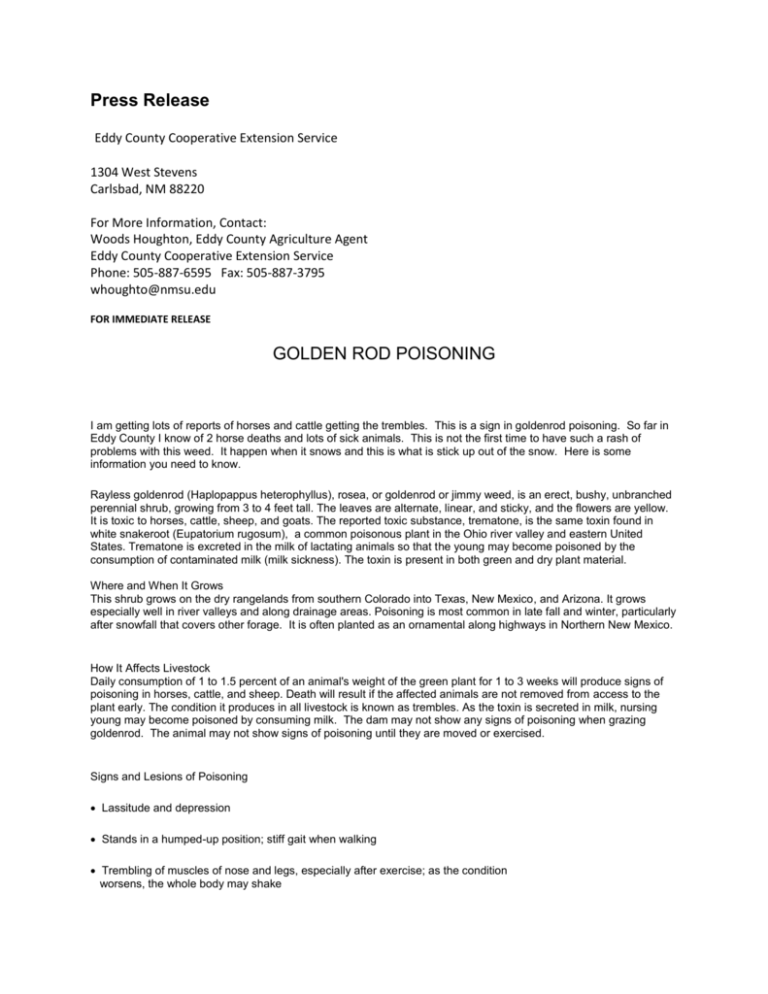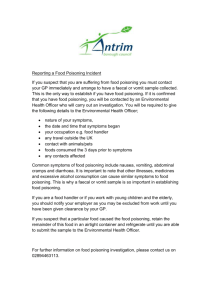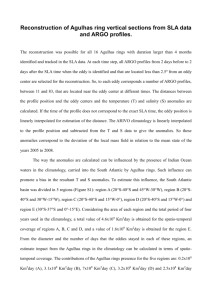Golden Rod 2010 - Eddy County Cooperative Extension Service
advertisement

Press Release Eddy County Cooperative Extension Service 1304 West Stevens Carlsbad, NM 88220 For More Information, Contact: Woods Houghton, Eddy County Agriculture Agent Eddy County Cooperative Extension Service Phone: 505-887-6595 Fax: 505-887-3795 whoughto@nmsu.edu FOR IMMEDIATE RELEASE GOLDEN ROD POISONING I am getting lots of reports of horses and cattle getting the trembles. This is a sign in goldenrod poisoning. So far in Eddy County I know of 2 horse deaths and lots of sick animals. This is not the first time to have such a rash of problems with this weed. It happen when it snows and this is what is stick up out of the snow. Here is some information you need to know. Rayless goldenrod (Haplopappus heterophyllus), rosea, or goldenrod or jimmy weed, is an erect, bushy, unbranched perennial shrub, growing from 3 to 4 feet tall. The leaves are alternate, linear, and sticky, and the flowers are yellow. It is toxic to horses, cattle, sheep, and goats. The reported toxic substance, trematone, is the same toxin found in white snakeroot (Eupatorium rugosum), a common poisonous plant in the Ohio river valley and eastern United States. Trematone is excreted in the milk of lactating animals so that the young may become poisoned by the consumption of contaminated milk (milk sickness). The toxin is present in both green and dry plant material. Where and When It Grows This shrub grows on the dry rangelands from southern Colorado into Texas, New Mexico, and Arizona. It grows especially well in river valleys and along drainage areas. Poisoning is most common in late fall and winter, particularly after snowfall that covers other forage. It is often planted as an ornamental along highways in Northern New Mexico. How It Affects Livestock Daily consumption of 1 to 1.5 percent of an animal's weight of the green plant for 1 to 3 weeks will produce signs of poisoning in horses, cattle, and sheep. Death will result if the affected animals are not removed from access to the plant early. The condition it produces in all livestock is known as trembles. As the toxin is secreted in milk, nursing young may become poisoned by consuming milk. The dam may not show any signs of poisoning when grazing goldenrod. The animal may not show signs of poisoning until they are moved or exercised. Signs and Lesions of Poisoning Lassitude and depression Stands in a humped-up position; stiff gait when walking Trembling of muscles of nose and legs, especially after exercise; as the condition worsens, the whole body may shake Weakness Constipation and dribbling of urine Recumbency Acetone odor on the breath Coma Terminal respiration consists of prolonged inspiration, a short pause, and forced expiration Death Myocardial necrosis and fibrosis of cardiac and skeletal muscles Degenerative changes of the liver How to Reduce Losses If you have an animal that show symptoms, try not to move or excite the animal and feed good quality hay for up to 10 weeks. Treat with mineral oil and activated charcoal if possible to move the toxic weed out of the digestive system as soon as possible. Consult with your Veterinarian immediately after seed symptoms. Poisoning of livestock by rayless goldenrod can best be prevented by preventing livestock from grazing on ranges infested with this plant for extended periods. Rayless goldenrod can be controlled by a number of herbicides picloram or dicamba and milestone in late summer following adequate rainfall. Follow precautions for handling herbicides. Eddy County Extension Service, New Mexico State University is an equal opportunity/affirmative action employer and educator. All programs are available to everyone regardless of race, color, religion, sex, age, handicap, or national origin. New Mexico State University, U.S. Department of Agriculture, and the Eddy County Government Cooperating Eddy County Extension Service and New Mexico State University is an equal opportunity employer and educator. Eddy County Government, New Mexico State University and the U.S. Department of Agriculture cooperating, to put knowledge to work. Woods E. Houghton Eddy County Agriculture Extension Agent 1304 West Stevens Carlsbad, NM 88220 Office phone: (575) 887-6595 Cell phone: (575) 361-2852 E-mail: whoughto@nmsu.edu Web page: http://eddyextension.nmsu.edu











